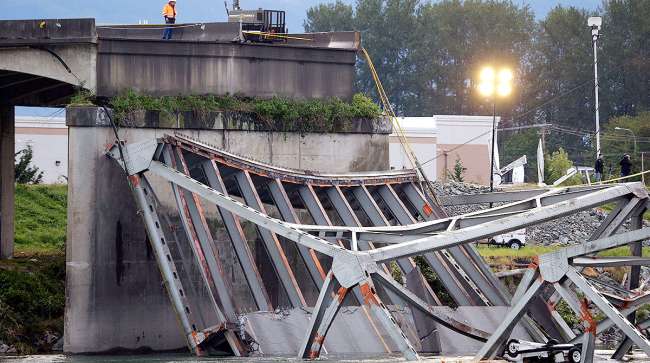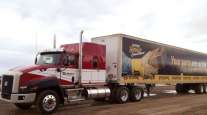Staff Reporter
Washington Supreme Court Finds State Not at Fault for Skagit River Bridge Collapse

[Stay on top of transportation news: Get TTNews in your inbox.]
The Supreme Court of Washington has determined the Washington Department of Transportation cannot be held at fault for an interstate bridge collapse that occurred in 2013.
The court’s opinion, filed Oct. 31, found “no fault may be allocated to the state.”
The incident took place when William Scott, a driver for Mullen Trucking Corp., was transporting an oversize load across the Skagit River Bridge when his vehicle struck 11 of the structure’s sway braces, causing a portion of the bridge to collapse into the river. Two other vehicles fell into the water, but there were no fatalities. Three people were treated for minor injuries.
The Skagit River Bridge carries Interstate 5 in Burlington, Wash., some 50 miles south of the Canadian border.
Scott was driving in the right lane when the incident occurred. The bridge’s vertical clearance varied, allowing more vertical capacity in the center than at the edge. The court document indicates that, if Scott had been driving in the left lane, his truck would have cleared the bridge.
On the bridge, a Motorways Transport truck driven by Amandeep Sidhu was “halfway beside” Scott on his left, limiting Scott to the right side of the structure. Motorways Transport is a Canadian trucking company based in British Columbia. Scott coasted to the end of the bridge, understanding what had occurred only when he looked back and saw the damage. Sidhu did not stop and said he didn’t know what had occurred.
“The investigation team determined the proximate cause of this collision sequence was directly attributable to Scott’s negligence,” the court document states.
Scott’s truck was preceded by a pilot vehicle, which was outfitted with a clearance pole to help gauge whether height-restricted structures could accommodate the truck. Tammy Detray, who operated the pilot vehicle, was talking on a hands-free cellphone during the crossing and stated the pole did not strike the bridge, although that account was contradicted by a witness.
“Detray was only 4.12 seconds ahead of Scott,” the court document states. “According to experts, even if Detray had alerted Scott to a clearance issue, Scott was too close to alter his path.”
Scott was cited for negligent driving. The state sued Scott, Mullen Trucking, Motorways Transport and other parties for $17 million for negligence. The trucking companies counterclaimed, saying the state also was negligent. Their claims were based on multiple grounds, such as the state’s duty to maintain bridges and the fact that the bridge had been deemed “functionally obsolete,” meaning it was built according to standards that are no longer in practice today.
In a dissenting opinion, Justice Charles Wiggins said the state still may be allocated fault for failing to maintain its roads and bridges.
Phil Talmadge, an attorney representing Washington Trucking Associations, said the court’s decision exemplifies the need for legislative action to ensure the state is held responsible for negligence regarding bridges.
“There should be no special treatment of the state or its political subdivisions,” Talmadge said.

Petrich
WSDOT spokeswoman Andrea Petrich said, once the state Supreme Court decision becomes final, the case will return to the Skagit County Superior Court.
“Affirming the decision of two lower courts, the Supreme Court held WSDOT fulfilled all of its statutory obligations with respect to the bridge and is not responsible for paying any part of the more than $17 million it took to repair the bridge,” Petrich said. “Several of the defendants already have admitted their actions caused the bridge collapse. Nevertheless, they still have not paid any portion of the more than $17 million in repair costs they admit the state appropriately expended to repair the bridge.”
Washington’s bridges received a C+ on the American Society of Civil Engineers’ infrastructure report card, which was issued in January.
Mullen Group Ltd., based in Alberta, Canada, ranks No. 53 on the Transport Topics Top 100 list of the largest for-hire carriers in North America.
Want more news? Listen to today's daily briefing:



